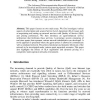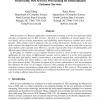JDCTA
2010
14 years 7 months ago
2010
Unwanted traffic injection which amplifies the traffic loading and exhausts network resources is counted as network security threat. Despite of the numerous protection systems, th...
ICSOC
2009
Springer
14 years 10 months ago
2009
Springer
Abstract. Moving towards a global market of services requires flexible infrastructures that will deal with the inevitable semantic heterogeneity that occurs during the negotiation ...
101
click to vote
NETWORK
2007
15 years 15 days ago
2007
— Two rate SLAs become increasingly popular in today’s Internet, allowing a customer to save money by paying one price for committed traffic and a much lower price for additio...
103
click to vote
SOFTWARE
2002
15 years 19 days ago
2002
This paper focuses on two main areas. We first investigate various aspects of subscription and session Service Level Agreement (SLA) issues such as negotiating and setting up netwo...
108
Voted
COMCOM
2004
15 years 26 days ago
2004
Allocating resources in networks to QoS flows may require undesirable delays or costs. We consider a dynamic Service Level Agreement (SLA) negotiation scheme between peer autonomo...
CN
2004
15 years 26 days ago
2004
Due to the autonomous nature of ISPs, the service level agreement (SLA) offering is currently confined to within a single provider network. In this work, we examine some methods o...
130
Voted
TELSYS
2008
15 years 27 days ago
2008
With the number of e-Business applications dramatically increasing, a service level agreement (SLA) will play an important part in Web services. The SLA is a combination of severa...
108
Voted
JSW
2006
15 years 29 days ago
2006
When having repeated interactions with a service provider, a service consumer might desire guarantees on the delivery of the service. These guarantees involve both functional and n...
113
click to vote
FGCS
2006
15 years 1 months ago
2006
Web and grid services are quickly maturing as a technology that allows for the integration of applications belonging to different administrative domains, enabling much faster and ...
CORR
2010
Springer
15 years 1 months ago
2010
Springer
In the current Internet, there is no clean way for affected parties to react to poor forwarding performance: to detect and assess Service Level Agreement (SLA) violations by a con...




